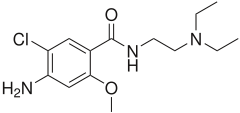Metoclopramide (injection)
 | |
 | |
| Clinical data | |
|---|---|
| Pregnancy category | |
| Routes of administration | Oral, IV, IM |
| ATC code | |
| Legal status | |
| Legal status |
|
| Pharmacokinetic data | |
| Bioavailability | 80±15% (oral) |
| Metabolism | Hepatic |
| Elimination half-life | 5–6 hours |
| Excretion | 70–85% renal, 2% faecal |
| Identifiers | |
| |
| CAS Number | |
| PubChem CID | |
| DrugBank | |
| E number | {{#property:P628}} |
| ECHA InfoCard | {{#property:P2566}}Lua error in Module:EditAtWikidata at line 36: attempt to index field 'wikibase' (a nil value). |
| Chemical and physical data | |
| Formula | C14H22ClN3O2 |
| Molar mass | 299.80 g/mol |
Metoclopramide (INN) (IPA: Template:IPA) is a potent dopamine receptor antagonist used for its antiemetic and prokinetic properties. Thus it is primarily used to treat nausea and vomiting, and to facilitate gastric emptying in patients with gastric stasis.
It is available under various trade names including: Maxolon (Shire/Valeant), Reglan (Wyeth), Degan (Lek), Maxeran (Sanofi Aventis), Primperan (Sanofi Aventis), and Pylomid (Bosnalijek). It was protected under U.S. patent 3177252 until 6 April 1982.
Mode of action
Metoclopramide was first described by Dr. Louis Justin-Besançon and C. Laville in 1964.[1] It appears to bind to dopamine D2 receptors where it is a receptor antagonist, and is also a mixed 5-HT3 receptor antagonist/5-HT4 receptor agonist.
The anti-emetic action of metoclopramide is due to its antagonist activity at D2 receptors in the chemoreceptor trigger zone (CTZ) in the central nervous system (CNS)—this action prevents nausea and vomiting triggered by most stimuli.[2] At higher doses, 5-HT3 antagonist activity may also contribute to the anti-emetic effect.
The prokinetic activity of metoclopramide is mediated by muscarinic activity, D2 receptor antagonist activity and 5-HT4 receptor agonist activity.[3][4] The prokinetic itself may also contribute to the anti-emetic effect.
Clinical use
Antiemetic use
Metoclopramide is commonly used to treat nausea and vomiting (emesis) associated with conditions including: emetogenic drugs, uraemia, radiation sickness, malignancy, labor, and infection.[5][6] It is also used by itself or in combination with paracetamol (acetaminophen) for the relief of migraine.
It is considered ineffective in postoperative nausea and vomiting (PONV) at standard doses, and ineffective for motion sickness.[5][6] In nausea and vomiting associated with cancer chemotherapy, it has been superseded by the more effective 5-HT3 antagonists (e.g. ondansetron).
Prokinetic use
Metoclopramide increases peristalsis of the jejunum and duodenum, increases tone and amplitude of gastric contractions, and relaxes the pyloric sphincter and duodenal bulb. These prokinetic effects make metoclopramide useful in the treamtent of gastric stasis (e.g. after gastric surgery or diabetic gastroparesis), as an aid in gastrointestinal radiology by increasing transit in barium studies, and as an aid in difficult small intestinal intubation. It is also used in gastroesophageal reflux disease (GERD/GORD).
Other indications
By inhibiting the action of prolactin inhibiting hormone (i.e. dopamine), metoclopramide has sometimes been used to stimulate lactation.
Contraindications/precautions
Metoclopramide is contraindicated in phaeochromocytoma. It should be used with caution in Parkinson's disease since, as a dopamine antagonist, it may worsen symptoms. Long-term use should be avoided in patients with clinical depression as it may worsen mental state.[6] Also contraindicated with a suspected bowel obstruction.
Adverse effects

Common adverse drug reactions (ADRs) associated with metoclopramide therapy include: restlessness, drowsiness, dizziness, and/or headache. Infrequent ADRs include: extrapyramidal effects (EPSE) such as oculogyric crisis (and other acute dystonic reactions), hypertension, hypotension, hyperprolactinaemia leading to galactorrhoea, diarrhoea, constipation, and/or depression. Rare but serious ADRs associated with metoclopramide therapy include: agranulocytosis, supraventricular tachycardia, hyperaldosteronism, neuroleptic malignant syndrome and/or tardive dyskinesia.[6]
The risk of EPSEs are increased in young adults (<20 years) and children.[6] Such dystonic reactions are usually treated with benztropine or procyclidine. The risk of tardive dyskinesia and EPSE is increased with high dose therapy and with prolonged use. Tardive dyskinesias may be persistent and irreversible in some patients.[5]
References
- ↑ Justin-Besançon L, Laville C. Action antiémétique du métoclopramide vis-à-vis de l'apomorphine et de l'hydergine [Antiemetic action of metoclopramide with respect to apomorphine and hydergine]. C R Seances Soc Biol Fil 1964;158:723–7. PMID 14186927.
- ↑ Rang HP, Dale MM, Ritter JM, Moore PK. Pharmacology. 5th ed. Edinburgh: Churchill Livingstone; 2003. ISBN 0-443-07145-4
- ↑ Sweetman S, editor. Martindale: The complete drug reference. 34th ed. London: Pharmaceutical Press; 2004. ISBN 0-85369-550-4
- ↑ Tonini M, Candura SM, Messori E, Rizzi CA. Therapeutic potential of drugs with mixed 5-HT4 agonist/5-HT3 antagonist action in the control of emesis. Pharmacol Res 1995;31(5):257-60. PMID 7479521
- ↑ 5.0 5.1 5.2 Valeant Pharmaceuticals. Maxolon (Australian Approved Product Information). Auburn (NSW): Valeant Pharmaceuticals Australasia; 2000.
- ↑ 6.0 6.1 6.2 6.3 6.4 Rossi S, editor. Australian Medicines Handbook 2006. Adelaide: Australian Medicines Handbook; 2006. ISBN 0-9757919-2-3
Further reading
- Brenner GM. Pharmacology. London: W B Saunders; 2000 ISBN 0-7216-7757-6
- Canadian Pharmacists Association. Compendium of Pharmaceuticals and Specialties. 25th ed. Toronto: Webcom; 2000. ISBN 0-919115-76-4
- Practical Gastroenterology May 2004 Recognition of Movement Disorders and Extrapyramidal side effects - would you recognize them if you see them?. Available on practicalgastro.com
Template:Propulsives nn:Metoklopramid de:Metoclopramid sv:Metoklopramid
- Pages with script errors
- Drugs with non-standard legal status
- E number from Wikidata
- ECHA InfoCard ID from Wikidata
- Chemical articles with unknown parameter in Infobox drug
- Articles without EBI source
- Chemical pages without ChemSpiderID
- Articles without KEGG source
- Articles without InChI source
- Articles without UNII source
- Articles containing unverified chemical infoboxes
- Antiemetics
- Dopamine antagonists
- Motility stimulants
- Drugs